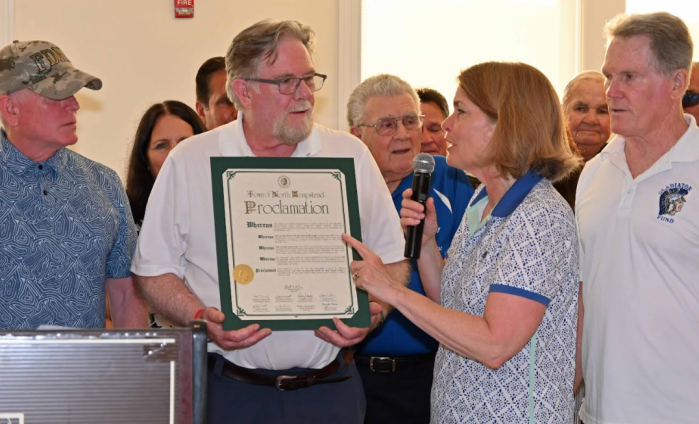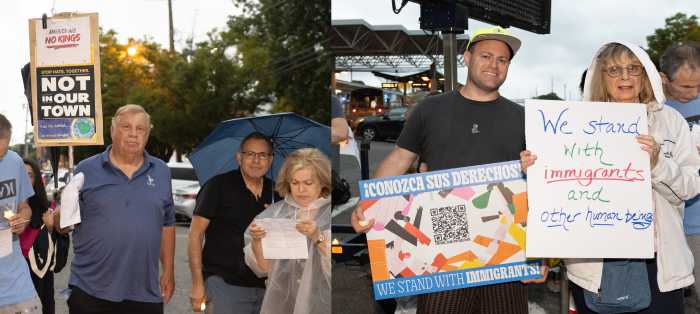Board of Trustees Holds June Scoping Hearing
Some residents criticized the draft scope for the Draft Environmental Impact Statement (DEIS) for the proposed demolition of Ellis Hall and the Main Building at St. Paul’s at a June 4 scoping hearing.
Robert Grover, director of the consulting firm Greenman-Pedersen, Inc. out of Babylon, noted that the village board and members of the engineering and construction services firm’s consulting team have identified some issues in a preliminary list. “We’re all here to see if anything needs to be added,” Grover said at the scoping meeting.
Trustees, on April 17, issued a positive declaration of the proposed demolition action, which required the preparation of the DEIS. A positive declaration means the proposed action could have significant adverse environmental impacts.
As it stands now the issues included in the draft environmental impact statement include aesthetic resources, historic resources, impacts on open space and hazardous materials, including lead paint and mold, public health and safety issues, community character and construction impacts.
Brixton Road resident Robert Vassalotti questioned why potentially significant adverse impacts, specifically public health and safety as well as community character, were not further exemplified in the DEIS.
“Although I do believe they will be studied, however, the document does not reflect that in an adequate order or significant paragraph,” Vassalotti said. “I would like to see this document edited to a) number it effectively, and b) include public health and safety and community character in a paragraph describing further study and impact.”
Alternatives to be included in the DEIS are no action, which would leave the buildings as they currently exist, stabilization of the structures and their mothballing for an indeterminate future use and adaptive reuse of the buildings.
Ed Keating of Euston Road, a member of the executive committee of the Committee To Save St. Paul’s, said the term “mothballing” carries a negative connotation. “This should be changed to the less prejudicial phrase ‘preserving the structures,’” Keating told trustees.
Keating further criticized the document, noting that it makes only a “superficial effort” to identify the impact categories to be analyzed in the DEIS and the analysis methodologies.
“As the lead agency, the board is required to specify the ‘extent and quality of information needed for the preparer to adequately address each impact, including the identification of relevant existing information and required new information, including required methodologies for obtaining new information.’ The document is sadly inadequate in complying with this rule,” he said.
St. Paul’s School is listed on the National Register of Historic Places. Keating said the document fails to fully introduce a qualified historic consultant: “We heard mention tonight of a Dr. Bernstein. Don’t know who that person is. There is no explanation of what makes the person qualified. Indeed, there’s no description of the assignment. Much more information is needed. Simply stating that the services of a qualified historic resource consultant will be employed says almost nothing.”
Keating continued, “There should be ample opportunity for interested members of the community to comment and critique anyone considered for such an assignment. What we don’t need is the hiring of someone who simply gives back to the board what it wants to hear. We know from experience that money can buy almost any opinion. You need an objective review of the impact of demolishing this historic treasure and the public needs input on who is selected.”
If approved, demolition will occur in five phases. In Phase 1, any historic elements identified as required to be preserved during preparation of the DEIS and Final Environmental Impact Statement (FEIS) will be removed and appropriately preserved. In Phases 2 and 3, all hazardous materials, including lead paint and mold, will be handled in accordance with all federal, state and county regulations and guidelines. Further, all non-structural recyclable materials will be removed and transported to recycling facilities. In Phase 4, the building structures will be demolished. Lastly, in Phase 5, the site will be appropriately graded, restored and landscaped for its intended use – open space.
Various community groups, including the Committee to Save St. Paul’s, have been exploring alternative uses of the building. Keating urged trustees to include input from such groups in the draft scope before a decision is made.
“The board does not have a stellar track record when it comes to transparency and soliciting public input,” Keating criticized. “There are too many last minute agenda changes and surprise additions to be a coincidence. Promises to keep the public fully involved have been regularly forgotten.”





























